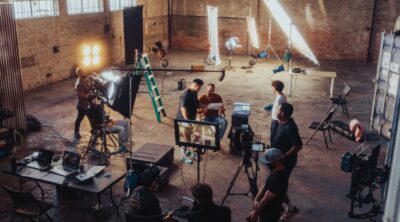< Back to all posts
What Broadcast & Video Teams Can Learn From Hollywood’s COVID-19 Protocols
Video content is a valuable tool for communication during the COVID-19 pandemic. People around the world are using videos to stay in touch now that social distancing has made face-to-face contact impossible. From musicians taking their concerts online and corporate boards meeting on video calls, audiovisual content is everywhere – but there’s a major catch.
The inability for people to gather safely has made it impossible for full-scale video production to go ahead as it did before the pandemic. A person sitting in front of a computer and filming on a webcam is one thing, and a complete video shoot is another. When can the latter start back up, and how will best practices change to allow the safe filming of these videos?
With businesses opening up again, small and medium scale video shoots and small studio productions with live talent are now becoming common. But that doesn’t come without a long list of restrictions and protocols to help ensure the shooting space is safe and comfortable.
How is Hollywood coping?
One place companies can look when considering the future of their own video productions is the work being done on large-scale and high-profile film and television shoots. CNBC recently reported on how blockbuster crews are getting their projects moving amid the highly “TBD” situation regarding coronavirus closures.
Different studios are taking varied approaches to reopening. Some productions, including those using large amounts of computer-generated effects, are beginning production anew in a virtual format. Studios that have already used CG to replace backgrounds and create composite shots of actors interacting have found these tools are allowing them to complete some shots without uniting the cast.
Even more ambitious than harnessing existing technologies, some film studios are trying new production approaches that will enable the creation of full-looking crowd shots without violating social distancing rules, and with a reduced need for post-production.
CNBC explained that Rebellion Studios, which is primarily a developer of video games, is using its engine to program virtual film sets. Without the need for teams to be physically present to run cameras and lights, shoots can proceed with far fewer people on set. A virtual production allows crews to generate backgrounds for their motion-capture performances in real-time while the actors are doing their work on the stage.
Of course, introducing more virtual and remote control into film production is not a cure-all, even for the largest and most technologically enabled Hollywood studios. CNBC reported that there is a lack of training associated with new methods.
With behind-the-scenes talent putting in time and effort to make large-scale virtual productions more efficient and financially viable outside of large film studios, the lasting legacy of the COVID-19 lockdown could include new paradigms for content creation across visual media. Film, TV – and corporate video productions – may have new possibilities in the years to come.

Lasting opportunities for video
Companies need to ask themselves what their objective is in creating videos. There is an even greater need for visual content today, especially with the need to replace marketing channels with the cancellation and postponement of many conferences and other large-scale in-person events.
Businesses that usually communicate to their employees, shareholders and customers through conferences and meetings with presentations and keynotes need alternative ways to demonstrate their new products and their value propositions. These firms will be able to get their messaging on video long before it is safe to hold a full-scale industry gathering. This means visual content stands poised to be a more central branding tool than ever before in the months (or years) ahead.
Video is effective for messaging in a socially distanced context, but doesn’t lose its value even when people are allowed to congregate. For that reason, the months ahead may be pivotal for businesses either restarting their video content creation programs or embracing digital communication for the first time. In an era when everything from technology industry conferences to shareholder calls is moving to streaming, the importance of high video production values has never been more clear.
If you’re ready to get started on your next on-location shoot, contact one of our Production Managers here at Crews Control, or click here.







Leave a Reply